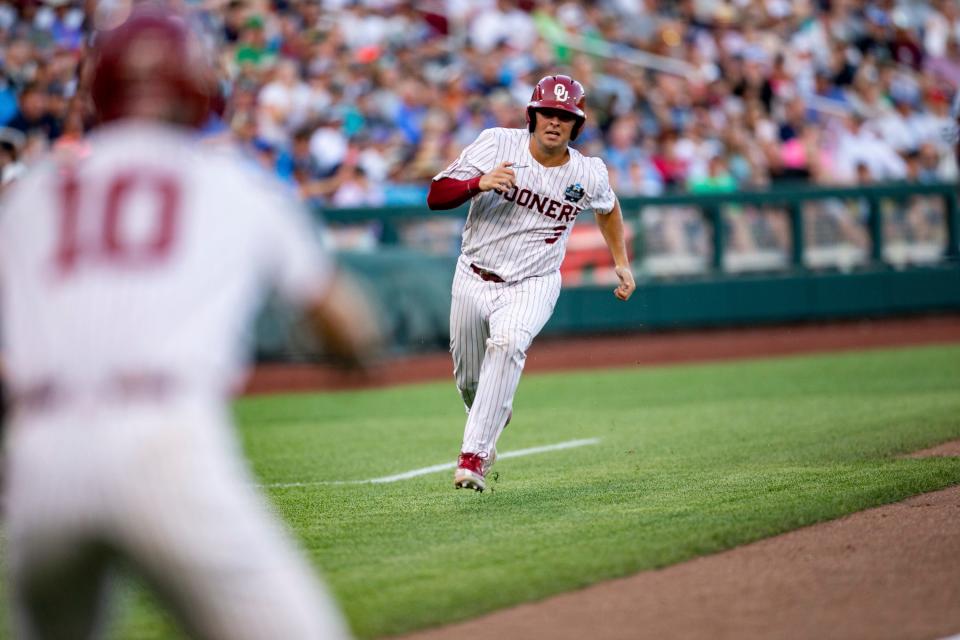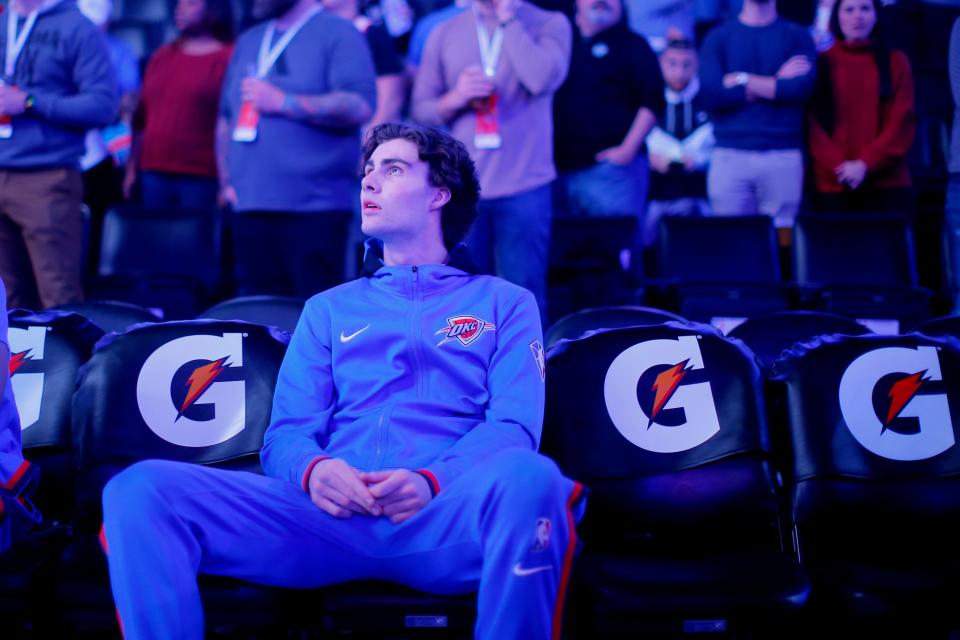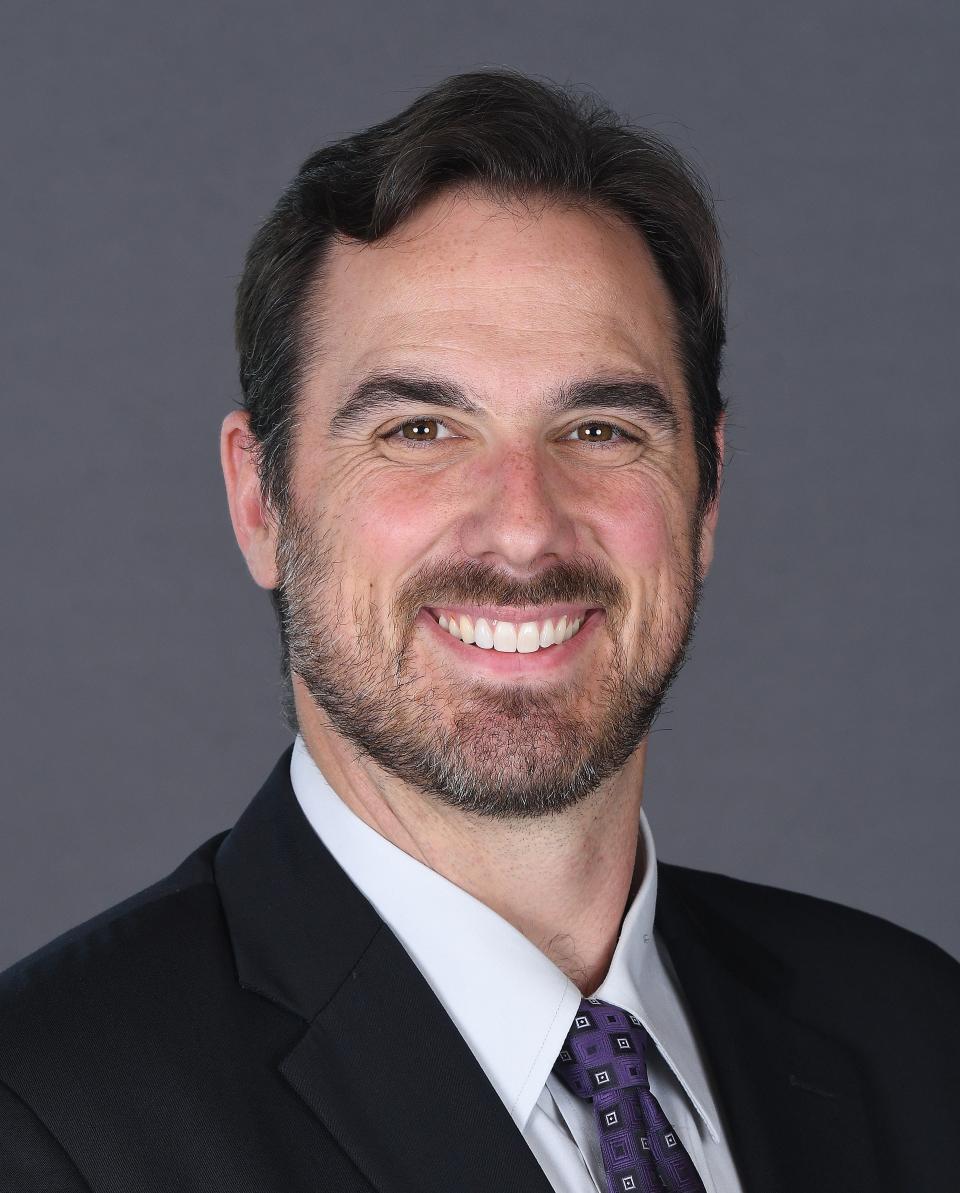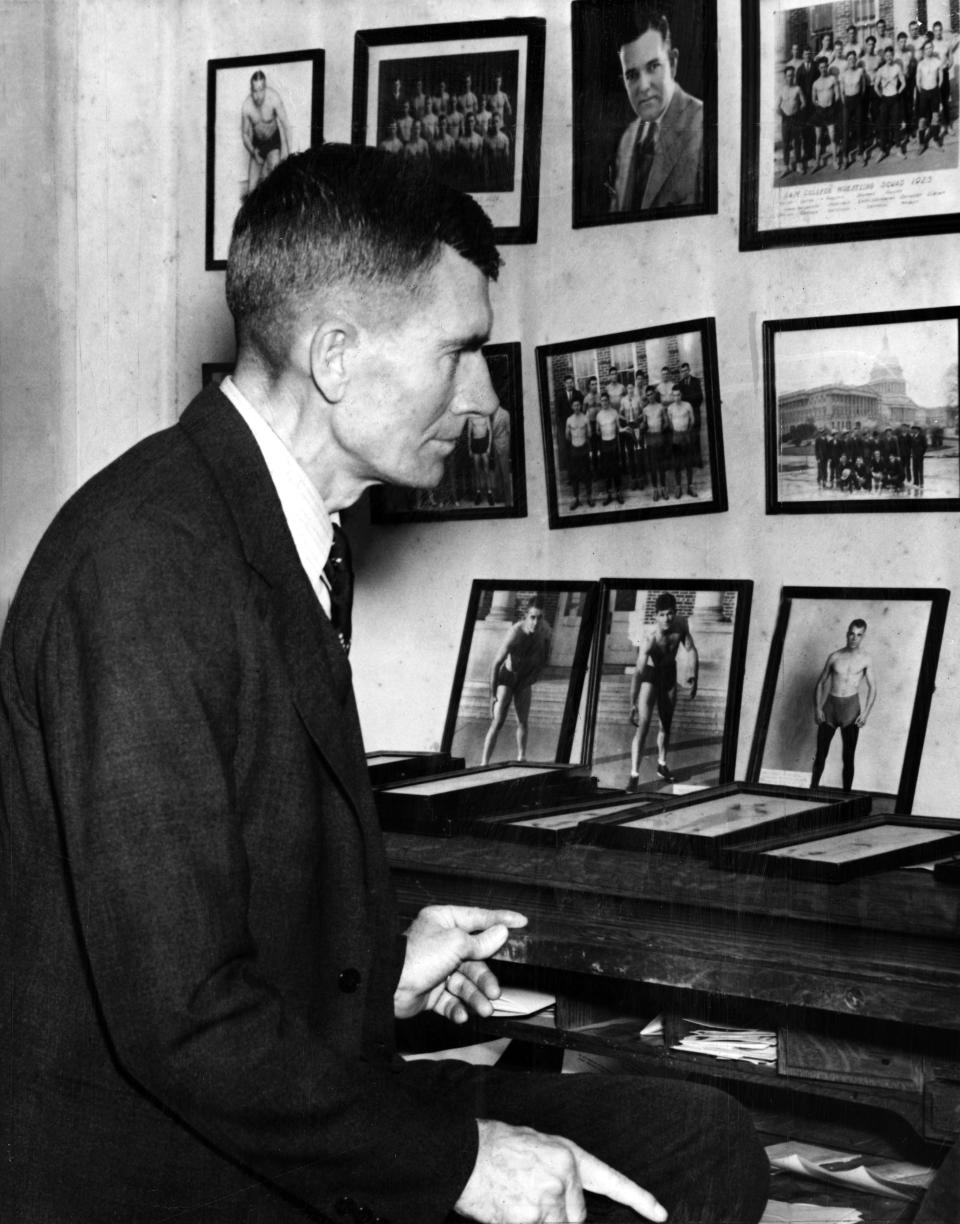Tramel's ScissorTales: OU baseball latest example of College World Series Cinderellas
College baseball can be short of charm.
The games are insufferably long. OU’s College World Series games so far have gone 3:32 (Notre Dame) and 3:57 (Texas A&M). The Sooners’ final two super regional games at Virginia Tech went 3:15 and 3:50.
The games can get one-sided. Only two of OU’s nine NCAA playoff games have been decided by fewer than four runs.
For those of us in softball country, watching the slow-paced games in Omaha immediately after watching the fast-paced games in OKC amounts to downright torture.
But OU’s ascension to baseball’s final four this crazy month of June has spotlighted a glorious thing about Omaha. The men’s College World Series is Cinderella Central.
No other American championship offers such opportunity for underdogs.
'Keep riding it': OU baseball beats Notre Dame, moves a win away from College World Series finals
More: How Kendall Pettis recovered to break out for OU baseball on College World Series run
Baseball by nature is a more random sport than most. The best team in baseball will average winning only about two of three from the worst team in baseball.
Perhaps only the National Hockey League playoffs can match baseball for randomness. But most of the professional ranks do not have the mighty gulf between haves and have-nots that exist in much of collegiate sports.
Here’s what’s incredible about the current College World Series. The Sooners aren’t even the biggest Cinderella story among the two remaining unbeatens.
Ole Miss was the last team selected for the NCAA playoffs and was a 3-seed in the Coral Gables Regional. OU was at least a 2-seed when sent to the Gainesville Regional.
And Omaha has a proud history of producing unsuspecting champions.
Since the current seeding format began in 1999, five Omaha champions have been a 2-seed or lower. If a 2-seed doesn’t sound all that low, consider this: baseball 2-seeds are the equivalent of teams seeded 5-8 in the NCAA basketball tournament.
And over the 38 years of the 64-(or 68)team basketball bracket, three true Cinderellas still were waltzing when the big dance ended – 8-seed Villanova in 1985, 6-seed Kansas in 1988 and 7-seed Connecticut in 2014.
Those teams are the basketball equivalents of a team like the 2022 Sooner baseball squad.
Cal State-Fullerton in 2004 and Coastal Carolina in 2016 were 2-seeds that won it all in Omaha.
But the College World Series can trump even that. Virginia in 2015 and Oregon State in 2007 won the NCAA title as 3-seeds, which equates to a basketball seed of 9-12. Five times in March Madness, an 11-seed has made the Final Four – 1986 Louisiana State, 2006 George Mason, 2011 Virginia Commonwealth, 2018 Loyola-Chicago (way to go, Porter Moser) and 2021 UCLA. But none of those teams advanced to the championship game.
Carlson: As OU baseball chases College World Series title, it can add to Sooners' spectacular spring

And here’s the capper for college baseball. Fresno State in 2008 was a 4-seed in its regional, the equivalent of a basketball 13-16 seed. Those Bulldogs won the national title.
The pros have little history of such underdog success.
The National Football League is bullish on parity, and big upsets are not only rare, but often not even possible. Since the NFL playoffs expanded to 12 teams in 1990, four teams seeded fifth or sixth in their conference’s six-team playoffs won the Super Bowl – the 2005 Steelers and 2010 Packers are 6-seeds; the 2007 Giants and 2020 Buccaneers as 5-seeds. But maybe only those ‘07 Giants truly could be called a Cinderella.
In the NBA playoffs, the lowest-seeded champions were the 1969 Celtics (4-seed) and the 1995 Rockets (6-seed). Neither were sweeping floors; both were defending champions.
Major League Baseball doesn’t really have equivalent seeding. Since the playoffs expanded to include a wild-card play-in game in 2012, three wild-card teams have emerged to win the World Series – the 2011 Cardinals, 2014 Giants and 2019 Nationals. Perhaps Washington 2019 is the best parallel to OU and Ole Miss; the Nats were sputtering much of the season before catching fire.
Probably hockey is the closest thing to Omaha. The 2012 Los Angeles King won the Stanley Cup as an 8-seed; the 1980 New York Islanders and the 1995 New Jersey Devils won as 5-seeds. Still, the Kings won over 14 teams seeded higher. If Ole Miss wins the baseball championship, it will have jumped about 40 teams.
“Obviously, baseball is a big momentum game, and we're building a lot of momentum right now,” said Ole Miss pitcher Hunter Elliott. “That's obviously what you look to do in the postseason, and getting hot is a true thing in baseball. Just keep building confidence, that's what we look to do.”
Ole Miss coach Mike Bianco concurred.
“It’s been a neat run,” said Bianco. “Getting hot’s real. It's not just some facetious … it's confidence, kids playing well. So, when they're doing that, sometimes the best thing you can do as a coach is let them go. Sometimes the best thing you can do is just get out of their way.”
Maybe that’s what OU coach Skip Johnson has done. The Sooners are playing quite aggressively, and even when that backfires, OU is undeterred.
Auburn coach Butch Thompson took note of the Sooners.
“I was watching Oklahoma last night,” Thompson said, “and they made the first and third out at third base, and everyone is throwing trash at them.
“I'm like, ‘They're right where they need to be. They're playing, attacking and they're going for it.’”
The Sooners indeed are right where they need to be. In Omaha. The home of Cinderellas.
Tramel's ScissorTales: Thunder needs 3-point shooting; here's how draft prospects shoot

NBA drafting of internationals changing
In each of the last two NBA Drafts, the Thunder’s first first-round pick was an international player without American experience. No college basketball. No G League. No Overtime Elite.
Australian Josh Giddey, picked sixth overall in 2021, played for the Adelaide 36ers of Australia’s high-level National Basketball League. Serbia’s Aleksej Pokusevski, picked 17th overall in 2020, played one game in the high-level EuroLeague but spent his final pre-NBA season in Greece’s second-tier professional league.
The Thunder has been swimming against the tide.
Fewer and fewer international players without American experience are being selected in recent years.
In the 2016 NBA Draft, seven first-round picks were international players who did not have American experience. Since then, those numbers have been two, two, three, four and three.
And the 2022 NBA Draft, which arrives Thursday, isn’t expected to change the trend.
Of the 14 projected lottery picks, using nba.com’s consensus of prospects, only France’s Ousmane Dieng did not play college hoops or for one of the development programs that have emerged the last couple of years. Dieng played for the New Zealand Breakers of Australia’s NBL.
International players seem to getting to the U.S. for college (and high school) more than ever. Canadians Shaedon Sharpe (Kentucky, though he didn’t play, for mysterious reasons) and Bennedict Mathurin (Arizona), plus Englishman Jeremy Sochan (Baylor) landed on campus. Aussie Dyson Daniels played for the G League Ignite, the NBA’s alternative for players still too young for the draft but with limited desire for college.
Four other international players are listed among the top 40 prospects by nba.com. Two went to college – Cameroon's Christian Koloko (Arizona) and Canada’s Caleb Houstan (Michigan) -- and another, the Dominican Republic’s Jean Montero, played for Overtime Elite, an Ignite equivalent.
So among the top 40, only Serbia's Nikola Jovic and Dieng are without at least one season of U.S. basketball experience. Jovic played this past season in the Adriatic Basketball League’s first tier, which features clubs from the former Yugoslavia (Bosnia and Herzegovina, Croatia, Montenegro, North Macedonia, Serbia and Slovenia.
The Thunder has a decent history on hitting in the draft with international players.
Sam Presti gets a lot of credit for his successive lottery picks of Kevin Durant, Russell Westbrook and James Harden, and while only Durant was considered a sure-fire star, they still were high lottery picks. More impressive was his 2008 selection of Serge Ibaka at No. 24 overall. Ibaka became a foundational Thunder.
Presti also took Alex Abrines in the 2013 second round, and Abrines was a solid player for a second-rounder. Giddey appears to be a home-run pick.
Other Presti picks of players with no American experience include 2020 second-rounders Theo Maledon and Vit Krejci. Maledon has had his moments; Krejci, we’ll see.
Counting players who did play in college (or with an American developmental league), the Thunder has taken about 10 international players during the Presti years, depending on how you count players who were part of draft-night trades. That’s somewhere in the middle of the pack. The Philadelphia 76ers, for example, have taken 21 during that time.
The effect of the Ignite and Overtime Elite, as well as more internationals coming to U.S. universities, is more access for American scouts.
The sharp franchises – the Spurs come to mind – got ahead in the last 20 years or so with international scouting. Tony Parker and Manu Ginobili were prime examples.
But now, more internationals are coming to the U.S., and scouting is easier than ever, though the pandemic certainly skewed that the last two years.
Surprises always arise in the NBA Draft. But more and more, the names you hear called Thursday night will be names you know.
More: Shaedon Sharpe's OKC Thunder ties & takeaways from top NBA prospects' pre-draft interviews

K-State promotes Lepak
Brian Lepak came to OU without a scholarship. He transferred from Colorado State, ended up climbing the depth chart as an undersized offensive lineman and started some on the Sooners’ 2010 Big 12 championship team.
Lepak went to OU Law School and got his law degree in 2014. Lepak was set to join an Oklahoma City law firm but instead gave coaching a try. He spent three seasons at Indiana and three more at OU, all as a graduate assistant or quality control coach, then coached a year at Southern U., in 2020.
Lepak joined Kansas State’s staff in 2021 back in quality-control, but earlier this, KSU coach Chris Klieman promoted Lepak to tight ends and fullbacks coach.
D. Scott Fritchen of kstatesports.com did a lengthy Q&A with Lepak, which you can read here.
Here are some of the highlights from Lepak.
On getting hired: “I was down in Oklahoma. When Coach Klieman called me and told me about my new role, I was very honored. It’s a good thing that it wasn’t in person, you know? I was driving between high schools and had to pull over on the side of the road to do a FaceTime with him.
“I got off the phone and called my wife right away. She’s had to go along for the ride the whole time, all these years. It was a big deal for me, but also for my wife. She got emotional about it.”
On his path: “I didn’t think I had the easiest path to play college football. I wasn’t heavily recruited. I wasn’t the most talented guy, but I was a hard-working guy, so I felt like a lot of the culture here at K-State reflected me personally. The moment I got here, what became apparent to me was this was a fit, this was a place where I belonged.”
On law school: “I was supposed to start my job at a law firm in Oklahoma City. About two weeks before the bar, and I got a call from Kevin Wilson. Wilson was the head coach at Indiana, and he was my offensive coordinator when I played at Oklahoma. He’s the one that told me, ‘If you’re thinking about coaching, make sure it’s what you really want to do.’ A lot of guys get finished playing and they don’t know if they just miss playing or if they really want to coach.
“I flew up there the week before the bar, got the job, and came back. At this time, I was in Norman, my wife was working as a nurse at a children’s hospital in Fort Worth, and she was taking a job at Oklahoma City where I was originally going to be working. We were dating at the time, and I planned at the time to take the signing bonus from the law firm I was going to work at, and buy a ring, and get engaged in September. All of that went out the window.
“I took the bar exam Tuesday and Wednesday. On Thursday, I packed up. Friday, I took my stuff to my parents’ house in Claremore and got engaged that night without a ring. Then Saturday morning, I got up, told my parents what I did, got into the car, drove to Bloomington, Indiana, and started fall camp on Sunday. She relocated to Bloomington after that first season. We got married that summer, Fourth of July of 2015. She’s a trooper.”
More: Dyson Daniels and six players OKC Thunder might target with No. 12 pick in NBA Draft
The List: NBA Draft No. 12 picks
The Thunder has the No. 2 and No. 12 picks in the 2022 NBA Draft, and it’s only natural to focus on No. 2. But No. 12 can be a place to find a quality ballplayer, too.
The success rate for No. 12 picks is somewhere below 50 percent. No superstar has been picked No. 12, unless you count Julius Erving, who already was an American Basketball Association star and had signed with the Atlanta Hawks, but was picked in 1972 at No. 12 by the Milwaukee Bucks, who were trying to nab Erving through the backdoor.
Still, No. 12 is not a bad place from which to choose. Here are the 10 best No. 12 picks in NBA history, and remember, Tyrese Haliburton and Miles Bridges soon will join this list:
1. Paul Silas, 1964: Silas played 16 NBA seasons, winning titles with the 1974 and 1976 Celtics, plus the 1979 Sonics. He’s 22nd all-time in NBA rebounds and was a long-time defensive force.
2. Mookie Blaylock, 1989: The great ballhawk on Billy Tubbs’ grand OU teams of 1987-89, Blaylock was a 1994 all-star and a two-time first-team all-defense selection.
3. Larry Costello, 1954: The six-time all-star was second-team all-NBA in 1961. He later coached Milwaukee to the NBA title.
4. Cornbread Maxwell, 1977: The spiritual leader of the Larry Bird Celtics, Maxwell played 11 NBA seasons and averaged 12.5 points a game.
5. Rudy LaRusso, 1959: Known mostly as being traded for Wilt Chamberlain in 1967, LaRusso was a good center for a full decade, averaging 15.6 points and 9.4 rebounds.
6. Jim Paxson, 1979: Not as famous as his brother, John, who was an NBA executive after he was Michael Jordan’s Bulls teammate, but Jim Paxson was the better player, lasting 10 years and averaging 14.3 points a game, including two Portland seasons in which he averaged over 20 points a game.
7. Muggsy Bogues, 1987: One of the NBA’s all-time great stories. A 5-foot-3 point guard who played 14 seasons, made 566 starts and averaged 7.6 assists per game.
8. Steven Adams, 2013: A bedrock of defense and rebounding during his seven years as the Thunder center, now about to enter his 10th NBA season.
9. Thaddeus Young, 2007: Just completed his 15th NBA season as a rebounder and defensive stalwart.
10. Don Chaney, 1968: Tall guard who was a defensive dynamo and a starter on Boston’s 1974 NBA title team.
'I'll just coach': How an Oklahoma State student went from HS cheerleader to NFL intern

Mailbag: Ed Gallagher
I wrote about OSU legend Ed Gallagher in the Friday ScissorTales, proclaiming him the Cowboys’ greatest coach ever. OSU fans were intrigued.
Terry: “Good article and hard to disagree, but if you include athletic directorship as part of coaching, Mike Holder would be my overall pick. One important fact I recall about Gallagher you left out is he had never previously wrestled himself. Don’t know if true, but that was part of his legend as I recall from many years ago. That always astounded me. Thanks for remembering a great man and coach.”
Tramel: Yes, it is true. Gallagher did not wrestle before instituting a wrestling program at OSU. Like I wrote, he was a tremendous athlete, particularly in track and football.
As for Holder, I concur. I think I mentioned that his administrative impact on the university was as profound as his effect on the golf program, which he coached to eight national titles.
Of course, if you go down that road, Henry Iba’s case improves, too.
Berry Tramel: Berry can be reached at 405-760-8080 or at btramel@oklahoman.com. He can be heard Monday through Friday from 4:40-5:20 p.m. on The Sports Animal radio network, including FM-98.1. Support his work and that of other Oklahoman journalists by purchasing a digital subscription today.
This article originally appeared on Oklahoman: OU Sooners baseball latest example of College World Series Cinderellas

